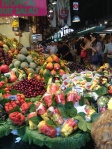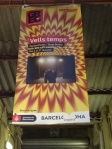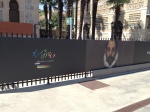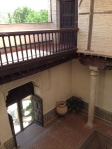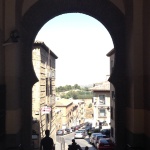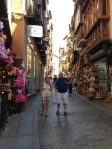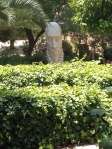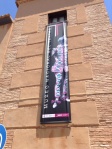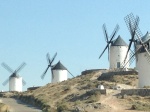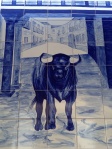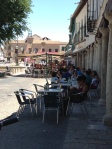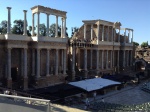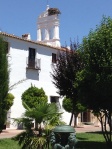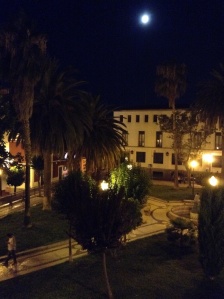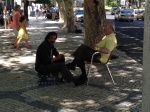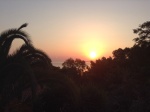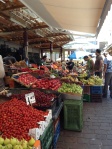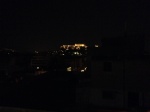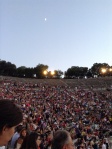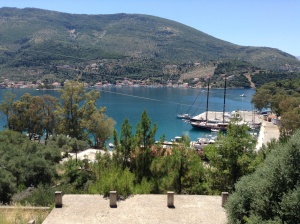 My final day was spent at Parc Guell and with this visit all my long held desires to explore Gaudi were realized. Again whimsy and practicality are forged with nature and this beautiful location captures the cool harbor breeze that eludes the town below. Gaudi, greatly informed by the ancient Greeks, has made our world a more beautiful and happier place.
My final day was spent at Parc Guell and with this visit all my long held desires to explore Gaudi were realized. Again whimsy and practicality are forged with nature and this beautiful location captures the cool harbor breeze that eludes the town below. Gaudi, greatly informed by the ancient Greeks, has made our world a more beautiful and happier place.
With a few hours to go before going to the theatre, I decided I really should try to do some shopping and so I started along the Ramblas only to find the last thing on my bucket list, the Gran Teatro Liceu and I was able to join the final tour of the day.
It really is a superb opera house in the Italian style. Privately owned for generations, it is now in the hands of the government. Its most recent refurbishment following a fire in the 1990s, has improved the acoustics, the staging, rehearsal and dressing rooms and made the previously exclusive grand reception area available for all patrons. It’s a lavish and very appealing theatre.
And finally after a sangria and a sit down it was time to find the Teatre Lluire on Mont Juic. I never did get to do any shopping. 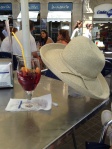
As I walked amongst the charming buildings of this arts precinct to get to the theatre, I discovered the Barcelona Institute of Theatre, an establishment that has always fascinated me in that it has a specific charter to teach, research, conserve, promote and innovate Catalan performing arts. It has also hosted many significant, international theatre studies conferences.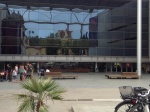
 Not knowing what sort of theatre is housing Ubu Roi, I’m astonished to find myself in the 1929 Palace of Agriculture, also built for the World Fair, now with a 2000 seater conversion in high Barcelona design. Even more astonishing is that I’m in the front row.
Not knowing what sort of theatre is housing Ubu Roi, I’m astonished to find myself in the 1929 Palace of Agriculture, also built for the World Fair, now with a 2000 seater conversion in high Barcelona design. Even more astonishing is that I’m in the front row.
And the play is also astonishing. With a fine pedigree coming from an invitation from Peter Brook, Cheek by Jowl created this production in co production with The Barbican, London.
Presented in French with Catalan surtitles, this is French high art in what I would expect from La Comedie-Francaise. Jarry’s, Ubu Roi (1896) is always open to extraordinary interpretations and while this was salon style farce in a proscenium arch theatre, it was not so much the interpretation that was astonishing but the performances particularly of Mere and Pere Ubu. However can I describe their energy and ability to turn on a sixpence? However can I even imagine what the rehearsal process must have been like to accomplish this level of slickness and how did the director know/ imagine what these people were capable of? How did he take them to those places? What an extraordinary accomplishment.
And please remember that I’m seeing this in a language I only just understand, so for the most part I’m missing the text and seeing French chic dissolve into the madness of vulgarity and scatology and back again. Really, for acting and production, this show takes the prize on this trip. Cheek by Jowl has presented a wonderful range of classics and this is no exception. I think there were at least 20 curtain calls. The audience went wild for it and so did I.
What a wonderful note on which to end this tour.My sincere thanks for all comments, tweets and follows. It’s been a joy to stay in touch.
The next tour? Same time, same station, 2015.
Please go to http://www.alltheworldsastagetheatretours.com for a full itinerary and to register your interest to See the World & See World Theatre. It’s a great experience.
In theater, there is nothing to understand, but to feel.
Louis Jouvert
French actor and director.






